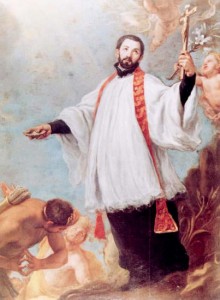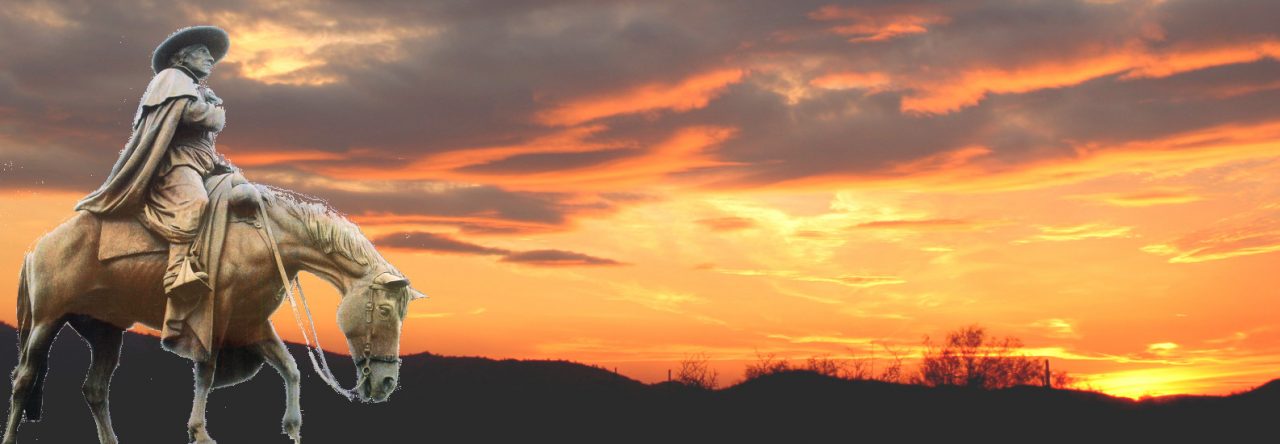This world-wide devotion was introduced in this region by Father Eusebio Francisco Kino, the 17th century Jesuit missionary. The nine days of prayer originated in Naples, Italy, in 1633 when a young Jesuit priest, Marcello Mastrilli, was asked to oversee the decoration of the Viceregal church for the feast of the Immaculate Conception. While he was adorning the altar, a hammer slipped from the hand of a craftsman working in the dome. Striking him on the temple, it knocked him to the ground. For several days he lingered near death; the attending physicians despaired of his recovery. At a crucial moment, St. Francis Xavier appeared to Mastrilli to remind him of his promise to go to the missions of the Orient. Before the apparition ended, Xavier assured him that “all who would earnestly ask his with God for nine days in honor of his canonization would infallibly experience the effects of his great power in heaven and would receive whatever they asked that would contribute to their salvation”.
with God for nine days in honor of his canonization would infallibly experience the effects of his great power in heaven and would receive whatever they asked that would contribute to their salvation”.
Immediately, Mastrilli rose up to find himself completely cured. He fulfilled his vow by accepting a missionary assignment to Japan, and in the ensuing years, he spread the devotion he had learned personally from the apparition of Xavier. Prior to his departure for Japan, he preached the devotion in Lisbon in 1635, and subsequently, because of the innumerable graces and extraordinary favors obtained by its means through the intercession of St. Francis Xavier, the devotion became known as the “Novena of Grace.” As Father Alex Tivipucci prayed throughout this novena: “Before Jesus and Mary Most Holy, I do not wish to owe my health to human means and forces or to the powers of medicine, but solely to you, my most glorious protector, St. Francis Xavier.”
These prayers embrace the spirit of St. Ignatius’ Suscipe: “Take O Lord and receive all my liberty, my memory, my understanding, and my entire will. Whatever I have or hold, You have given me; I restore it all to You and surrender it wholly to be governed by Your will. Give me only Your love and Your grace, and I am rich enough and ask for nothing more.”
DEVOTION TO ST. FRANCIS XAVIER IN THE SOUTHWEST OF THE U.S.A. AND IN THE STATE OF SONORA
Father Eusebio Francisco Kino, S.J., thirty-three years after the miraculous cure of Father Mastrilli, credited his own recovery from near death to the intercession of St. Francis Xavier. Like Father Marcello, Kino vowed to spend his life in the missions, finally arriving in the Pimería Alta (Sonora and Arizona) in 1687. After founding mission Dolores, his first visitas were dedicated in honor of Saints Ignatius and Xavier at the close of the celebration of the canonization of the two saints.
Kino was a fervent promoter of devotion to St. Francis Xavier, his own patron saint, whom he saw as the great protector of native peoples throughout northwest Mexico. The final days of Kino’s own life came at the very close of the Novena of Grace as he was dedicating a chapel in honor of Xavier in the mission pueblo of Magdalena, Sonora, March 15, 1711. Now nearly three centuries later, throngs of devout Christians flock to Magdalena each year to honor St. Francis Xavier — a kind of continuing Novena of Grace. Many say the pilgrimage also honors the “Apostle to the Pimas” just as much as the “Apostle to the Indies.“ Whether Kino or Xavier, they were each men of unwavering faith wholly dedicated to the salvation of the people they had come to serve.


 Italiano
Italiano Español
Español Deutsch
Deutsch